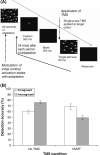State-dependency of transcranial magnetic stimulation
- PMID: 18791818
- PMCID: PMC3049188
- DOI: 10.1007/s10548-008-0067-0
State-dependency of transcranial magnetic stimulation
Abstract
Transcranial magnetic stimulation (TMS), a tool that allows noninvasive modulation of cortical neural activity, has become an important tool in cognitive neuroscience and is being increasingly explored in neurotherapeutics. Amongst the factors that are likely to influence its efficacy, the importance of the baseline cortical activation state on the impact of TMS has not received much attention. However, this state-dependency is important as the neural impact of any external stimulus represents an interaction with the ongoing brain activity at the time of stimulation. The effects of any external stimulus are therefore not only determined by the properties of that stimulus but also by the activation state of the brain. Here we review the existing evidence on the state-dependency of TMS and propose how its systematic study can provide unique insights into brain function and significantly enhance the effectiveness of TMS in investigations on the neural basis of perception and cognition. We also describe novel approaches based on this state-dependency which can be used to investigate the properties of distinct neural subpopulations within the stimulated region. Furthermore, we discuss how state-dependency can explain the functional mechanisms through which TMS impairs perception and behavior.
Figures



References
-
- Abbott LF, Nelson SB. Synaptic plasticity: taming the beast. Nat Neurosci. 2000;3:1178–1183. - PubMed
-
- Brighina F, Piazza A, Daniele O, Fierro B. Modulation of visual cortical excitability in migraine with aura: effects of 1 Hz repetitive transcranial magnetic stimulation. Exp Brain Res. 2002;145(2):177–181. - PubMed
-
- Campana G, Cowey A, Casco C, Oudsen I, Walsh V. Left frontal eye field remembers “where” but not “what”. Neuropsychologia. 2007;45(1):2340–2345. - PubMed
Publication types
MeSH terms
Grants and funding
LinkOut - more resources
Full Text Sources

